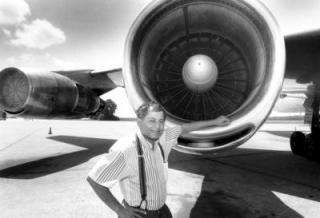Turning 'delayed' to 'on time' goal of UH professor in aircraft turbulence studies

Gridlock on airport runways is a common part of holiday travel, but one University of Houston engineering professor is researching ways to reduce airport delays by making runways usable more quickly.
Planes stir up the air considerably into swirling vortices when they take off and land, so the air has to settle down before any other plane can move safely through the space or consequences can be disastrous. The process can take minutes, consuming valuable time on airport runways both for takeoffs and landings. Multiplied over many arrivals and departures, these waits can contribute to long flight delays, especially at busier airports and during holiday congestion. The results are inconvenience and wasted time.
Working from a $300,000 grant from the National Science Foundation (NSF), Fazle Hussain, the Hugh Roy & Lillie Cranz Cullen Distinguished Professor of Mechanical Engineering at UH, is researching ways to reduce such delays by saving time between aircrafts during takeoffs and during landings.
Hussain’s approach is to speed the breakdown of vortices – whirling masses of air that suck everything nearby toward the center – to turbulence between planes. These tornado-like vortices left behind the generating aircraft are long-lived and create a potential hazard for trailing aircraft until broken down into turbulence, the latter of which takes precious time.
“When these delays become a big enough problem at an airport, the typical solution is to build a new runway. This can be costly, since the average runway costs more than $2 billion to build, and there isn’t enough land to build new runways in busy airports or in many big cities,” Hussain said. “To avoid these costs while still easing congestion, we will attempt to cause trailing vortices to break down into turbulence more quickly than they do naturally, thus encouraging their decay and making runways usable more quickly. All this is expected to be accomplished through the creation of near-axis swirl as suitable perturbations induced in trailing vortices.”
The research specifically concentrates on an aircraft’s pair of trailing vortices that are the swirling flow behind an airplane caused by the difference in air pressure above and below the plane’s wings. These vortices form at the tips of the wings and can remain energetic for large enough distances behind a plane to present dangers to other airplanes that encounter them. All such vortices naturally transition into turbulence eventually due to small disturbances that disrupt the orderly circular flow of air. The turbulent trailing vortex then decays relatively quickly, making it safe for additional aircraft to pass through the area once occupied by a vortex.
Initially using computer modeling, Hussain is testing the effects of adding an appropriate small device to the tip of an aircraft’s wings that will cause a rotation of air to introduce disturbances into the trailing vortex instead of waiting for them to occur naturally, resulting in the entire vortex-to-decayed-turbulence process being shortened. Hussain’s goals are to show that speeding the transition to turbulence is achievable, as well as be able to demonstrate and explain why and how it is possible.
A fluid dynamicist who specializes in aerodynamics, vortex dynamics and turbulence, Hussain has focused on the search for ‘order within disorder’ in fluid turbulence. As director of UH’s Institute of Fluid Dynamics and Turbulence, he is one of the leading experts in the field. He has published more than 250 scientific papers on this and related topics and is one of the most decorated fluid dynamicists, winning four of the field’s most coveted awards. Hussain was one of the first to recognize that the organized motion underlying the seemingly random motion of turbulence is the key to understanding turbulence and to controlling turbulent flows for technological benefit. Through his Aerodynamics and Turbulence Laboratory at UH, he is constantly placing together pieces of the puzzle to find significant applications for advances in the field.
Source: University of Houston





















